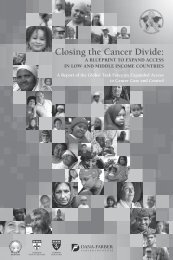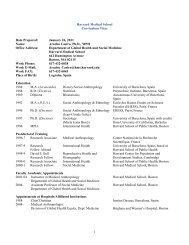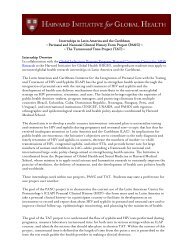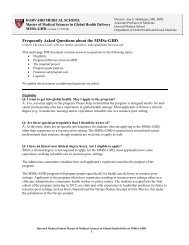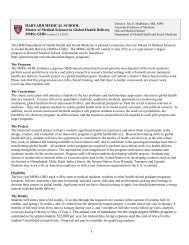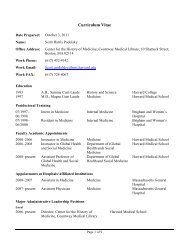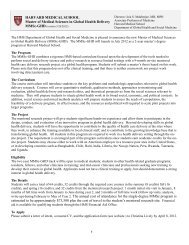Haiti Case Study - The Department of Global Health and Social ...
Haiti Case Study - The Department of Global Health and Social ...
Haiti Case Study - The Department of Global Health and Social ...
You also want an ePaper? Increase the reach of your titles
YUMPU automatically turns print PDFs into web optimized ePapers that Google loves.
SECURITY COMMUNITY AND THE HEALTH SYSTEM<br />
How did the security community participate in health system recovery <strong>and</strong> reconstruction when<br />
responding to the disasters?<br />
55. <strong>The</strong> <strong>Haiti</strong>an government declared the emergency within several hours after the<br />
earthquake <strong>and</strong> President René Préval immediately reached out to the international<br />
community to request relief assistance. Nations responded, in large part by deploying<br />
military assets. Nations turned to their militaries to provide response assets for a variety <strong>of</strong><br />
reasons including their ability to deploy immediately <strong>and</strong> in large numbers, their engineering<br />
<strong>and</strong> logistics capabilities, <strong>and</strong> their trauma care resources. <strong>The</strong> Inter-Agency St<strong>and</strong>ing<br />
Committee (IASC) Report gives an overview <strong>of</strong> international military contributions <strong>of</strong>fered by<br />
single <strong>and</strong> ad-hoc groups <strong>of</strong> nations:<br />
Twenty-six countries, including Argentina, Canada, France, Russia, the United Kingdom,<br />
<strong>and</strong> the US, provided significant military assets in support <strong>of</strong> the earthquake response,<br />
including field hospitals, troops, military aircraft, hospital ships, cargo ships, port h<strong>and</strong>ling<br />
equipment, <strong>and</strong> helicopters. 51<br />
56. <strong>The</strong> United States was the largest bilateral responder to <strong>Haiti</strong>’s earthquake given its<br />
proximity <strong>and</strong> numerous historical <strong>and</strong> political ties to <strong>Haiti</strong>. More than a dozen US<br />
government agencies participated in the response, which was led by the US government’s<br />
development <strong>of</strong>fice, the USAID. <strong>The</strong> US <strong>Department</strong> <strong>of</strong> Defense under Operation UNIFIED<br />
RESPONSE provided the overwhelming bulk <strong>of</strong> the United States’ relief contribution,<br />
deploying 22,000 personnel, 17 ships—including a hospital ship <strong>and</strong> several large<br />
amphibious ships equipped with tertiary care hospitals—<strong>and</strong> more than 100 aircraft to the<br />
response effort. <strong>The</strong>se forces were formed into Joint Task Force (JTF) <strong>Haiti</strong> under the<br />
comm<strong>and</strong> <strong>of</strong> US Southern Comm<strong>and</strong>’s Deputy Comm<strong>and</strong>er, Lt General Ken Keen, who<br />
happened to be present in <strong>Haiti</strong> at the time <strong>of</strong> the Earthquake on an <strong>of</strong>ficial visit to the<br />
country.<br />
57. Most <strong>of</strong> the military assets deployed were under national or multinational civilian<br />
leadership <strong>and</strong> control <strong>and</strong> were m<strong>and</strong>ated to provide immediate relief. In so doing military<br />
forces participated in a wide range <strong>of</strong> activities: search <strong>and</strong> rescue, running the airport,<br />
reopening the port, clearing rubble, distributing aid, directly providing medical treatment,<br />
participating in housing reconstruction plans, <strong>and</strong> providing security. 52 <strong>The</strong> US forces were<br />
instructed to “save lives” <strong>and</strong> “mitigate human suffering” by the Joint Task Force <strong>Haiti</strong><br />
comm<strong>and</strong>er; the three priorities in this effort were to provide critical medical aid, distribute<br />
food <strong>and</strong> water, <strong>and</strong> support search <strong>and</strong> rescue efforts 53 .<br />
58. Besides providing relief, it was also assumed that security, both for one’s own<br />
responders <strong>and</strong> for <strong>Haiti</strong> in general, would be a major concern in the disaster response since<br />
security organizations themselves were severely impacted by the earthquake. 54 <strong>The</strong> <strong>Haiti</strong>an<br />
police headquarters <strong>and</strong> 54 Police stations were destroyed in the capital <strong>and</strong> about 6000<br />
prisoners escaped from unattended or damaged prisons. 55 MINUSTAH itself had been badly<br />
affected by the earthquake.<br />
59. Given the uncertain security situation, Nations had different approaches regarding the<br />
security requirements <strong>of</strong> their troops: some deployed combat ready security forces wearing<br />
body armour; others arrived in fatigues with only light side arms; <strong>and</strong> still others adopted a<br />
low military pr<strong>of</strong>ile with focus on the medical <strong>and</strong> humanitarian relief 56 . <strong>The</strong> various postures<br />
were reported to have had an impact on the public perception <strong>of</strong> their role, with some worried<br />
that the influx <strong>of</strong> heavily armed troops denoted a military agenda. For example, one <strong>Haiti</strong>an<br />
<strong>of</strong>ficial said, “they must have thought we were the worst people in the world to come so<br />
heavily armed.”<br />
60. One <strong>of</strong> the first priorities <strong>of</strong> the JTF <strong>Haiti</strong> comm<strong>and</strong>er was to coordinate with the<br />
MINUSTAH Comm<strong>and</strong>er on the provision <strong>of</strong> security, for which MINUSTAH, despite its<br />
14




